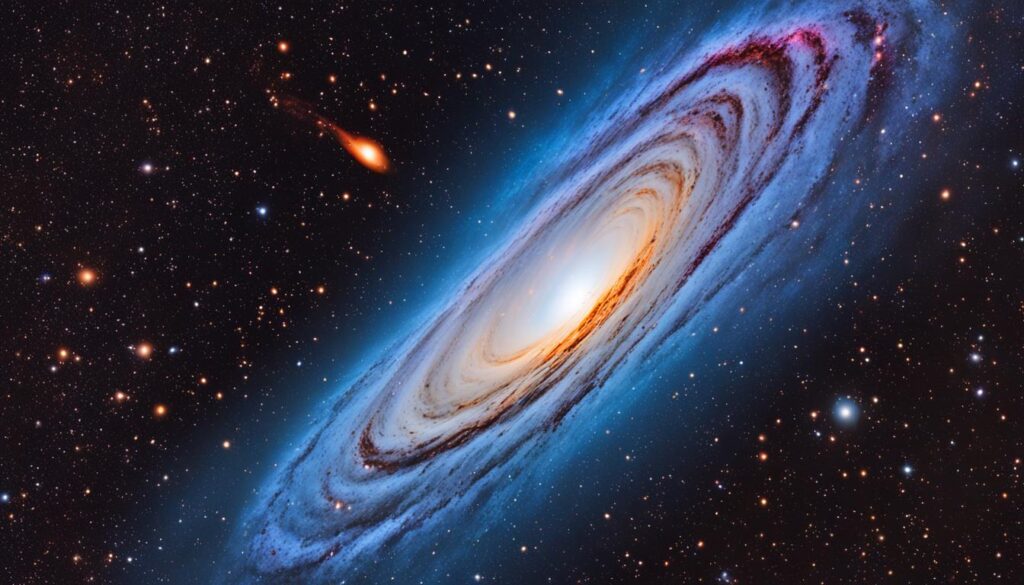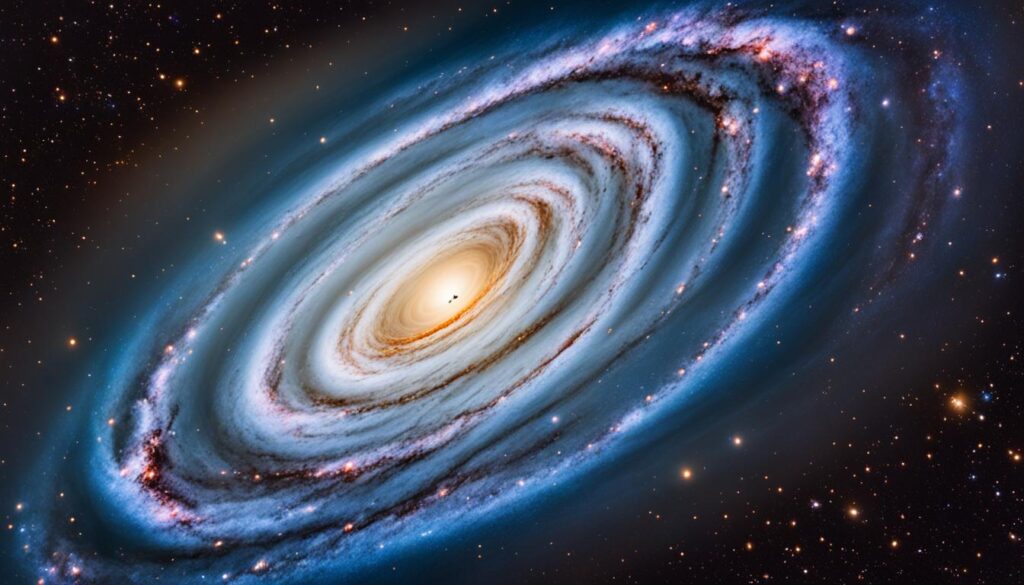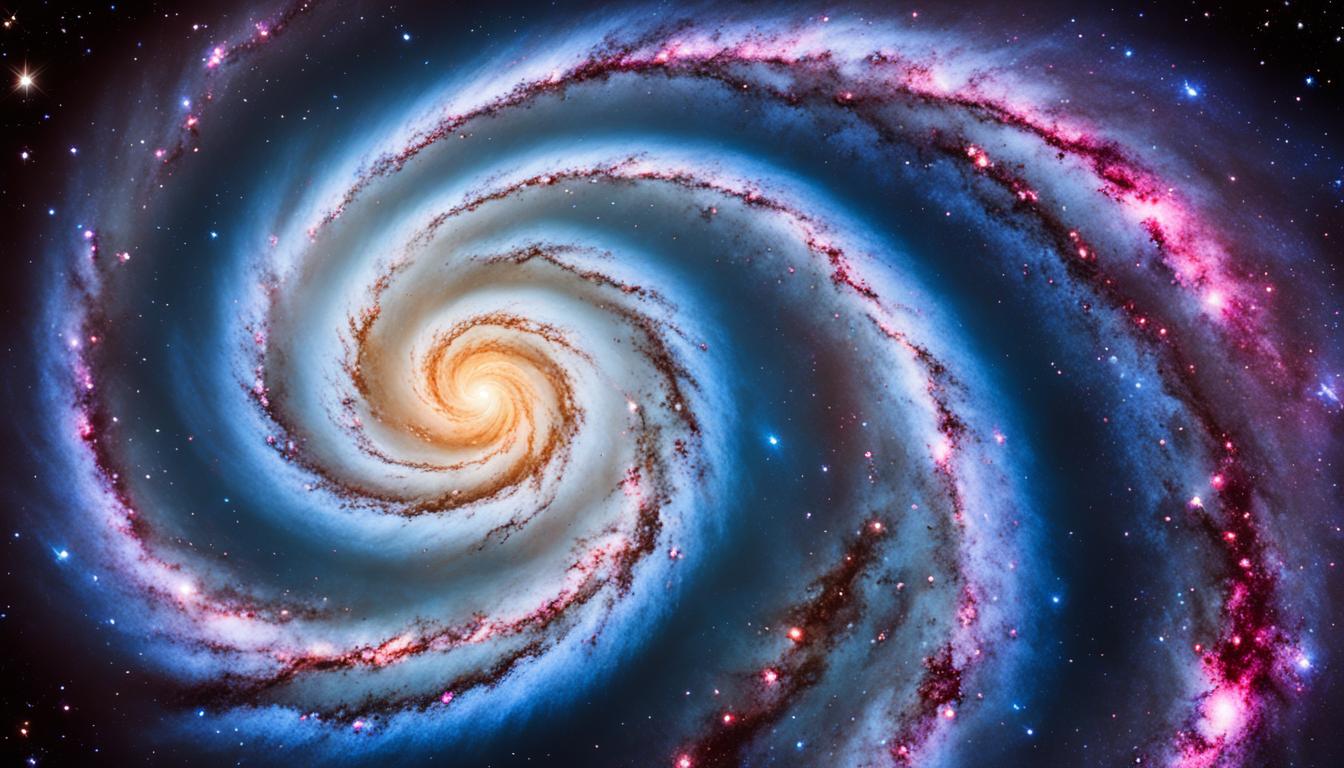Discover the mesmerizing beauty of Messier 95, a captivating celestial object nestled within the Leo constellation. Also known as M95 or NGC 3351, this spiral galaxy is a sight to behold, with its intricate structure and profound cosmic significance. As we delve into the depths of astronomy, we uncover the mysteries of space and the myriad wonders it holds.
Key Takeaways:
- Messier 95, also known as M95 or NGC 3351, is a mesmerizing barred spiral galaxy located in the Leo constellation.
- This celestial object is part of the renowned astronomical catalog created by Charles Messier, encompassing an extensive collection of deep sky objects.
- Messier 95 boasts a distinct spiral structure, with tightly wound arms and a central bar surrounded by a ring.
- Located approximately 33 million light-years away from Earth, this spiral galaxy holds immense value for astronomical research and space exploration.
- One of the remarkable aspects of Messier 95 is its active star-forming region, known as the circumnuclear region, which may pave the way for the creation of globular clusters.
Discovery and Cataloging
Messier 95, also known as M95 or NGC 3351, was discovered in 1781 by the French astronomer Pierre Méchain. Méchain reported his discovery to Charles Messier, an astronomer renowned for cataloging celestial objects. Just four days after its discovery, Messier included M95 in his extensive catalog of nebulous objects. He described it as a “feeble nebula, without a star,” highlighting its unique characteristics within the night sky.
The inclusion of Messier 95 in the catalog immortalized the galaxy’s discovery and paved the way for future astronomical research. Today, the galaxy is known by several designations, including M95, NGC 3351, UGC 5850, and PGC 32007.
Characteristics of Messier 95
Messier 95 is a fascinating barred spiral galaxy, classified as SB(r)b. This classification indicates that it possesses a central bar and loosely wound arms, distinguishing it from other types of spiral galaxies. The presence of a central bar adds an intriguing structure and dynamics to the galaxy’s overall appearance.
One of the distinctive features of Messier 95 is its prominent ring structure. This ring surrounds the central bar, creating a visually captivating formation. Within this ring, intense star formation takes place, making it a hub of cosmic activity. The energetic environment fosters the birth of new stars, as gas clouds collapse and form stellar nurseries.
This ring structure spans approximately 2,000 light-years, highlighting the vast scale of this fascinating cosmic masterpiece. Within the ring, astronomers have identified numerous star clusters and gas clouds, creating a stellar nursery teeming with stellar evolution and dynamic processes.
In 2012, a momentous event occurred in Messier 95. A Type II supernova, known as SN 2012aw, erupted within the galaxy, capturing the attention of astronomers worldwide. This supernova, resulting from the core-collapse of a massive star, unleashed a cataclysmic explosion and released an incredible amount of energy into the cosmos. The observation of this supernova provided valuable insights into the explosive processes that shape the universe.
To summarize, Messier 95 stands out due to its unique characteristics as a barred spiral galaxy, the presence of a prominent ring structure, active star formation, and the occurrence of a remarkable supernova. These characteristics make it a captivating subject for astronomical research and contribute to our understanding of the dynamic nature of galaxies and the vast universe in which they reside.
Location and Observability
Messier 95, a captivating celestial object, can be found in the Leo constellation. Located approximately a third of the way between the prominent stars Regulus and Denebola, this galaxy stands out amidst the night sky. Notably, Messier 95 is part of the M96 Group, which includes fellow galaxies Messier 96 and Messier 105, as well as several other less prominent members.
If you desire to catch a glimpse of Messier 95 and the nearby galaxies, the optimal time for observability is during the spring months. Under favorable conditions, even with a small telescope, you can marvel at the galaxy’s presence as it manifests as a diffuse oval ball of light. Its ethereal beauty adds to the fascination of exploring the Leo constellation and the wonders it holds.
Distance and Dimensions
When it comes to the vastness of the universe, understanding the distance and dimensions of celestial objects like Messier 95 is key. Messier 95 is located approximately 32.6 million light-years away from Earth, which means that the light we observe from this galaxy today has traveled through space for 32.6 million years to reach us. It’s a humbling realization that what we see in the night sky is a snapshot of the past.
In terms of its dimensions, Messier 95 is no small player in the cosmic arena. It has a diameter of about 80,000 light-years, making it a relatively large galaxy. To put this into perspective, the Milky Way, our home galaxy, has a diameter of about 100,000 light-years. This means that Messier 95 is comparable in size to some of the largest galaxies in the universe.
| Distance from Earth | Dimensions |
|---|---|
| Approximately 32.6 million light-years | About 80,000 light-years in diameter |
These dimensions are especially awe-inspiring when we consider the scale of the observable universe. The spatial extension of Messier 95, as measured by its apparent dimensions, is about 3.1 arc minutes by 2.9 arc minutes. This corresponds to a spatial extension of approximately 46,000 light-years. Imagine the immense scale of this galaxy, spanning thousands of light-years across the vast expanse of space.

Exploring the distant realms of our universe, such as Messier 95, allows us to marvel at the immense distances and dimensions that characterize the cosmos. It reminds us of the vastness of space and the mysteries that await us as we continue our journey of astronomical discovery.
Messier 95 and Star Formation
Messier 95, also known as M95 or NGC 3351, showcases an intriguing phenomenon within its ring structure – star formation. This region, called the circumnuclear region, spans 2,000 light-years in diameter and provides a fertile ground for the birth of new stars.
Within the circumnuclear region, several star clusters can be found, ranging in size from 1.7 to 4.9 parsecs. These clusters have a combined mass of 1.8 to 8.7 million solar masses, indicating the potential for significant star formation activities. The high concentration of stars in these clusters suggests that they may eventually evolve into globular clusters, which are densely packed spherical collections of ancient stars.
The star clusters within Messier 95’s circumnuclear region contribute to the ongoing evolution of the galaxy. They serve as hotbeds of stellar activity, where young stars are born from the interstellar gas and dust present in the region. As these stars form and mature, they inject energy and chemical elements into their surroundings, influencing the dynamics of the galaxy and shaping its future.
This vibrant process of star formation highlights the diverse and dynamic nature of galaxies like Messier 95. It is a testament to the continuous interplay between gravity, gas, and stellar evolution that drives the evolution of the universe at large.
Supernova in Messier 95
In 2012, a supernova named SN 2012aw illuminated the vast expanse of Messier 95, captivating astronomers worldwide. This astronomical event provided a unique opportunity to study the fascinating phenomenon of a core-collapse supernova in action. SN 2012aw belonged to the Type II-P category, also known as the “plateau” supernovae, characterized by a distinctive light curve with a prolonged plateau phase.
The light curve of SN 2012aw exhibited an intriguing behavior, displaying a significant flattening after 27 days. This phenomenon indicated a sustained and relatively stable luminosity during the plateau phase, allowing scientists to gather valuable data and insights into the mechanisms at work during a core-collapse supernova event.
Researchers estimated that the progenitor star of SN 2012aw had a mass of approximately 12.5±1.5 solar masses, further deepening the understanding of the stellar processes leading to violent and explosive stellar deaths.
| Type | SN designation | Light Curve | Progenitor Star Mass (solar masses) |
|---|---|---|---|
| Type II-P | SN 2012aw | Flattening after 27 days | 12.5±1.5 |
Messier 95 and the M96 Group
Messier 95, also known as M95 or NGC 3351, is part of the M96 Group, also referred to as the Leo I Group. This group consists of a collection of galaxies that are gravitationally bound within the larger Virgo Supercluster. Among the member galaxies of the M96 Group are Messier 96 (M96) and Messier 105 (M105), along with at least 21 other fainter members.
The M96 Group, including Messier 95, is situated in the Leo constellation, a prominent constellation in the northern celestial hemisphere. This group of galaxies exhibits a fascinating dynamics, as these galaxies are expected to undergo mergers and interactions over cosmic timescales. Eventually, these interactions will lead to the formation of a giant elliptical galaxy.
To provide a comprehensive overview, let’s delve deeper into the member galaxies of the M96 Group:
| Galaxy | Designation | Distance from Earth (light-years) | Diameter (light-years) |
|---|---|---|---|
| Messier 95 | M95, NGC 3351 | Approximately 32.6 million | Over 80,000 |
| Messier 96 | M96, NGC 3368 | Approximately 38 million | About 100,000 |
| Messier 105 | M105, NGC 3379 | Approximately 33 million | About 80,000 |
| Fainter Members: | |||
| … |
These member galaxies, along with others in the M96 Group, present a captivating cosmic tapestry, showcasing the intricacies of galactic evolution and the fascinating interactions occurring within this dynamic region of the universe.
Exploring the Leo I Group
To gain a better understanding of the Leo I Group and its member galaxies, astronomers utilize various observational techniques and instruments. Through the use of telescopes, such as the Hubble Space Telescope, astronomers have captured breathtaking images of these galaxies, enabling us to unravel their intricate details.
Infrared imaging has been instrumental in revealing the nuclear star-forming ring within Messier 95 and shedding light on the unresolved stellar populations within the galaxy. UV imaging has also provided valuable insights into the presence of massive star-forming regions and the potential influence of a nuclear spiral structure within the Leo I Group.
By studying the properties and interactions of the member galaxies in the M96 Group, astronomers gain valuable insights into the cosmic processes that shape galaxies and the larger structures of the universe.
Observations and Studies of Messier 95
Messier 95, also known as M95 or NGC 3351, has captivated astronomers and researchers, leading to various observations and studies that deepen our understanding of this remarkable galaxy. Through advanced technologies and innovative techniques, scientists have uncovered fascinating insights into the intricate details of Messier 95’s structure, star formation, and galaxy properties.
Hubble Space Telescope: Revealing the Spiral Structure and Star Formation

The Hubble Space Telescope, renowned for its profound contributions to astronomy and space exploration, has played a vital role in capturing detailed images of Messier 95. Its high-resolution capabilities have unveiled the galaxy’s mesmerizing spiral structure, showcasing the intricately intertwined arms that define its distinctive morphology. These breathtaking observations have allowed scientists to analyze the dynamics and evolution of Messier 95’s spiral arms.
This powerful instrument has also shed light on the process of star formation within Messier 95. By capturing the vivid colors and delicate features of star-forming regions, the Hubble Space Telescope has enabled researchers to study the intricate interplay between gas, dust, and stellar nurseries. These observations have deepened our understanding of the complex mechanisms that drive the birth of new stars within this awe-inspiring galaxy.
Infrared Imaging: Insights into the Nuclear Star-Forming Ring and Unresolved Stellar Populations
Infrared imaging techniques have provided valuable insights into the nuclear star-forming ring within Messier 95. By detecting the thermal radiation emitted by dust and gas, infrared observations have revealed the intricate structure and characteristics of this vital region. Scientists have been able to study the intense star formation processes occurring within this ring, further unraveling the complex dynamics of Messier 95’s central regions.
Moreover, the analysis of infrared data has allowed researchers to investigate the unresolved stellar populations within Messier 95. By studying the surface brightness fluctuations caused by individual stars, scientists have gained valuable information about the age, composition, and distribution of stars across the galaxy. This in-depth understanding of unresolved stellar populations has provided essential insights into galaxy properties and evolution.
UV Imaging: Highlighting Massive Star-Forming Regions and the Potential Influence of a Nuclear Spiral Structure
UV imaging techniques have provided unique perspectives on Messier 95, highlighting the presence of massive star-forming regions within the galaxy. These observations have revealed the intense ultraviolet radiation emitted by young, hot stars, providing valuable insights into the nature and distribution of these stellar nurseries. The UV images have allowed researchers to map the locations of these regions and study their influence on the overall structure and dynamics of Messier 95.
Furthermore, UV imaging has hinted at the potential influence of a nuclear spiral structure within Messier 95. The presence of these structures, radiating from the central regions, has been linked to the formation and evolution of galaxies. By analyzing the UV data, scientists have gained valuable clues about the underlying processes shaping the intricate morphology of Messier 95.
In section 9, we explore the diverse range of observations and studies that have deepened our understanding of Messier 95. With the aid of the Hubble Space Telescope, infrared and UV imaging techniques, researchers have uncovered captivating details about the galaxy’s spiral structure, nuclear star-forming ring, unresolved stellar populations, and massive star-forming regions. These valuable insights have revealed the remarkable nature and fascinating galaxy properties of Messier 95.
Historical Observations and Descriptions
Messier 95, or NGC 3351, has captivated astronomers throughout history with its fascinating visual appearance. Charles Messier, the renowned astronomer and celestial objects cataloger, initially cataloged this galaxy as a “feeble nebula, without a star.”
As subsequent observers turned their telescopes towards Messier 95, they noted its round and bright appearance, each adding their own unique observations. Admiral Smyth described the galaxy as having differences in definition and structure, while Sir William Herschel marveled at its distinctively hazy oval shape.
When gazing at Messier 95 in a visual observation, you will witness a mesmerizing sight—a hazy oval ball of light with a brighter center. Under optimal conditions, you may even catch a glimpse of its bar structure, adding to its allure.
FAQ
What is Messier 95?
Messier 95, also known as M95 or NGC 3351, is a barred spiral galaxy located in the Leo constellation.
Who discovered Messier 95?
Messier 95 was discovered by the French astronomer Pierre Méchain in 1781 and reported to Charles Messier.
How is Messier 95 classified?
Messier 95 is classified as a barred spiral galaxy, specifically SB(r)b, with tightly wound arms and a central bar surrounded by a ring.
Where is Messier 95 located?
Messier 95 is located in the Leo constellation, approximately a third of the way from the bright star Regulus to Denebola.
How far away is Messier 95?
Messier 95 is approximately 32.6 million light-years away from Earth and has a diameter of about 80,000 light-years.
Does Messier 95 have active star formation?
Yes, Messier 95 has an active star-forming region within its ring structure called the circumnuclear region.
Has a supernova been observed in Messier 95?
Yes, in 2012 a supernova named SN 2012aw was discovered in Messier 95, classified as a Type II-P core-collapse supernova.
What is the M96 Group?
The M96 Group, also known as the Leo I Group, is a collection of gravitationally bound galaxies that includes Messier 95, Messier 96, and Messier 105.
What observations and studies have been conducted on Messier 95?
Messier 95 has been observed and studied with the Hubble Space Telescope, infrared imaging, UV imaging, and surface brightness fluctuations.
What have historical astronomers observed and described about Messier 95?
Historical astronomers such as Charles Messier, Admiral Smyth, and Sir William Herschel have observed and described Messier 95, noting its round and bright appearance.






